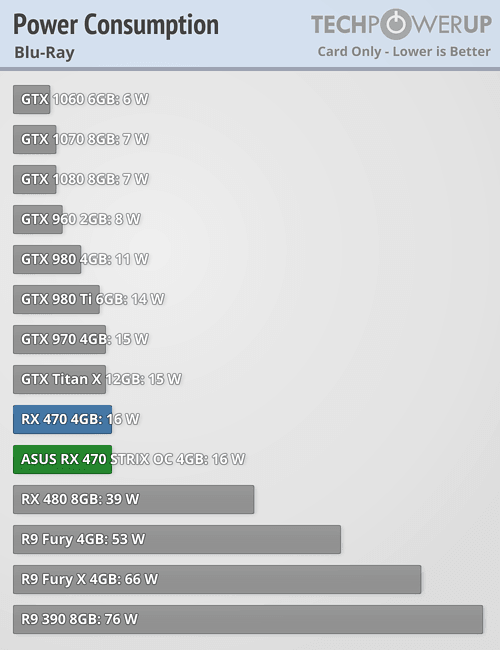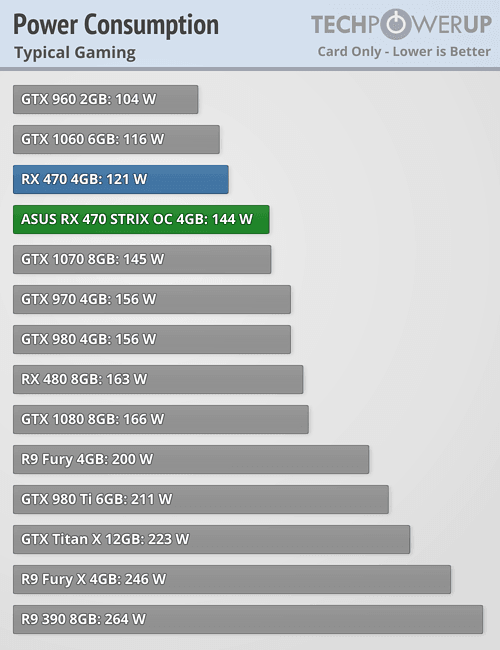 126
126
ASUS Radeon RX 470 STRIX OC 4 GB Review
Fan Noise »Power Consumption
Cooling modern video cards is becoming more and more difficult, especially with users asking for a quiet cooling solution, which is why engineers are now paying much more attention to the power consumption of new graphics card designs. An optimized fan-profile is also one of the few things board vendors can create to impress with reference designs where they are prohibited from making changes to the thermal solution or components on the card.
For this test, we measure the power consumption of only the graphics card via the PCI-Express power connector(s) and PCI-Express bus slot. A Keithley Integra 2700 digital multimeter with 6.5-digit resolution is used for all measurements. Again, these values only reflect the card's power consumption as measured at its DC inputs, not that of the whole system.
We use Metro: Last Light as a standard test for typical 3D gaming usage because it offers the following: very high power draw; high repeatability; is a current game that is supported on all cards; drivers are actively tested and optimized for it; supports all multi-GPU configurations; test runs in a relatively short time and renders a non-static scene with variable complexity.
Our results are based on the following tests:
Non-gaming power consumption of the RX 470 seems to be slightly improved over the RX 480, but not by enough to catch up with NVIDIA's Pascal cards. A very interesting and long overdue improvement is the low power consumption in Blu-ray playback. AMD is now finally running the card at idle clocks, whereas it ran the idle GPU clock, but had the memory run at its full speed in the past, resulting in massive power consumption. Let's hope this doesn't turn out to be a driver bug that gets "fixed" in the next release.For this test, we measure the power consumption of only the graphics card via the PCI-Express power connector(s) and PCI-Express bus slot. A Keithley Integra 2700 digital multimeter with 6.5-digit resolution is used for all measurements. Again, these values only reflect the card's power consumption as measured at its DC inputs, not that of the whole system.
We use Metro: Last Light as a standard test for typical 3D gaming usage because it offers the following: very high power draw; high repeatability; is a current game that is supported on all cards; drivers are actively tested and optimized for it; supports all multi-GPU configurations; test runs in a relatively short time and renders a non-static scene with variable complexity.
Our results are based on the following tests:
- Idle: Windows 10 sitting at the desktop (1920x1080) with all windows closed and drivers installed. The card is left to warm up in idle mode until power draw is stable.
- Multi-monitor: Two monitors are connected to the tested card, and both use different display timings. Windows 10 is sitting at the desktop (1920x1080+1280x1024) with all windows closed and drivers installed. The card is left to warm up in idle mode until power draw is stable. When using two identical monitors with the same timings and resolution, power consumption will be lower. Our test represents the usage model of many productivity users who have one big screen and a small monitor on the side.
- Blu-ray Playback: Power DVD 15 Ultra is used at a resolution of 1920x1080 to play back the Batman: The Dark Knight Blu-ray disc with GPU acceleration turned on. Measurements start around timecode 1:19, which has the highest data rates on the BD with up to 40 Mb/s. Playback keeps running until power draw converges to a stable value.
- Average: Metro: Last Light at 1920x1080 because it is representative of a typical gaming power draw. The average of all readings (12 per second) while the benchmark was rendering (no title/loading screen) is used. In order to heat up the card, the benchmark is run once without measuring power consumption.
- Peak: Metro: We use Last Light at 1920x1080 as it produces power draw typical to gaming. The highest single reading during the test is used.
- Maximum: We use Furmark Stability Test at 1280x1024, 0xAA. This results in a very high no-game power-consumption reading that can typically only be reached with stress-testing applications. We report the highest single reading after a short startup period. Initial bursts during startup are not included as they are too short to be relevant.
Gaming power consumption is considerably reduced over the RX 480, which ensures that the power input configuration doesn't get overloaded. With around 120 W, the AMD reference RX 470 consumes about as much power as NVIDIA's GTX 1060, which, however, is 35% faster in games. Compared to the RX480, the RX 470 is slightly more power efficient.
ASUS has overclocked their RX 470 out of the box, which yields increased performance, but it comes at the cost of efficiency. Compared to the RX 470 reference, efficiency is reduced by about 10%. Power consumption in all our tests is below the 150 W limit of the power input configuration, so all is good here.






Apr 9th, 2025 08:54 EDT
change timezone
Latest GPU Drivers
New Forum Posts
- RX 9000 series GPU Owners Club (267)
- GTX1080 Phoenix GLH broken? monitor signal but black screen? (1)
- worth overclocking 2666mhz cl19 ram for 1080p 75hz monitor? (7)
- The TPU UK Clubhouse (26070)
- ## [Golden Sample] RTX 5080 – 3300 MHz @ 1.020 V (Stock Curve) – Ultra-Stable & Efficient (32)
- Is RX 9070 VRAM temperature regular value or hotspot? (342)
- Windows 11 General Discussion (5951)
- ThrottleStop - 14900HX, 4090RTX MSI laptop (10)
- Kindly help in Identifying GPU and Suitable bios (16)
- Cant flash xfx rx5700 DD with any XT bios in Linux (0)
Popular Reviews
- The Last Of Us Part 2 Performance Benchmark Review - 30 GPUs Compared
- MCHOSE L7 Pro Review
- UPERFECT UStation Delta Max Review - Two Screens In One
- PowerColor Radeon RX 9070 Hellhound Review
- Sapphire Radeon RX 9070 XT Pulse Review
- Upcoming Hardware Launches 2025 (Updated Apr 2025)
- Sapphire Radeon RX 9070 XT Nitro+ Review - Beating NVIDIA
- ASUS Prime X870-P Wi-Fi Review
- AMD Ryzen 7 9800X3D Review - The Best Gaming Processor
- Acer Predator GM9000 2 TB Review
Controversial News Posts
- NVIDIA GeForce RTX 5060 Ti 16 GB SKU Likely Launching at $499, According to Supply Chain Leak (164)
- MSI Doesn't Plan Radeon RX 9000 Series GPUs, Skips AMD RDNA 4 Generation Entirely (146)
- Microsoft Introduces Copilot for Gaming (124)
- AMD Radeon RX 9070 XT Reportedly Outperforms RTX 5080 Through Undervolting (119)
- NVIDIA Reportedly Prepares GeForce RTX 5060 and RTX 5060 Ti Unveil Tomorrow (115)
- Over 200,000 Sold Radeon RX 9070 and RX 9070 XT GPUs? AMD Says No Number was Given (100)
- Nintendo Switch 2 Launches June 5 at $449.99 with New Hardware and Games (98)
- NVIDIA GeForce RTX 5050, RTX 5060, and RTX 5060 Ti Specifications Leak (97)